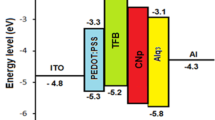Abstract
In this paper, p-chlorophenylacetic acid and p-fluorophenylacetic acid were applied to modify the indium tin oxide (ITO) electrodes. The surface work functions of unmodified ITO, p-chlorophenylacetic acid modified ITO (Cl-ITO) and p-fluorophenylacetic acid modified ITO (F-ITO) are 5.0 eV, 5.26 eV and 5.14 eV, respectively, and the water contact angles are 7.3°, 59.1° and 46.5°, respectively. The increase of the work function makes the hole injection ability of the devices improved, which is proved by the hole transport devices. The self-assembly (SAM) layers transfer hydrophilic ITO to hydrophobic ITO, which makes ITO more compatible with the hydrophobic organic layers, making the organic film more stable during the operation. After modification, the organic light emitting diodes (OLEDs), SAM-modified ITO/NPB/Alq3/LiF/Al, with better performance and stability were fabricated. Especially, the OLED with Cl-ITO (Cl-OLED) has a maximum luminance of 22 428 cd/m2 (improved by 32.9%) and a half-lifetime of 46 h. Our results suggest that employing organic acids to modify ITO surface can enhance the stability and the luminescent properties of OLED devices.
Similar content being viewed by others
References
K.Y. Dong, Z. Ming, J.J. Wang, W.U. Xiao-Lin and C.Y. Gao, Journal of Functional Materials 42, 306 (2011).
C. David, B.P. Tinkham, P. Prunici and A. Panckow, Surface & Coatings Technology 314, 113 (2017).
O. Mermer and Y. Asci, Journal of Optoelectronics & Advanced Materials 17, 1339 (2015).
H. Zheng, F. Zhang, N. Zhou, M. Sun, X. Li, Y. Xiao and S. Wang, Organic Electronics 56, 89 (2018).
Park, S.G. and T. Mori, ESC Journal of Solid State Science and Technology 6, R53 (2017).
H.U. Juntao, J. Yang, F. Peng, W. Mei and Y. Niu, Semiconductor Optoelectronics 38, 16 (2017). (in Chinese)
A. Bulusu, S.A. Paniagua, B.A. Macleod, A.K. Sigdel, J.J. Berry, D.C. Olson, S.R. Marder and S. Graham, Langmuir the Acs Journal of Surfaces & Colloids 29, 3935 (2013).
S. Besbes, A. Ltaief, K. Reybier, L. Ponsonnet, N. Jaffrezic, J. Davenas and H.B. Ouada, Synthetic Metals 138, 197 (2003).
R.A. Hatton, S.R. Day, M.A. Chesters and M.R. Willis, Thin Solid Films 394, 291 (2001).
X. Leihua, Z. Zhidan, T. Shuhua, J. Li and L. Jinlong, Journal of Dispersion Science and Technology 33, 1093 (2012).
D. Jeong, C. Lim, M. Kim, K. Jeong, J.-H. Kim, J. Kim, J.-G. Park, K.-S. Min and J. Lee, Electronic Materials Letters 13, 16 (2017).
J.A. Bardecker, H. Ma, T. Kim, F. Huang, M.S. Liu, Y.J. Cheng, G. Ting and K.Y. Jen, Advanced Functional Materials 18, 3964 (2008).
M. Can, A.K. Havare, H. Aydin, N. Yagmurcukardes, S. Demic, S. Icli and S. Okur, Applied Surface Science 314, 1082 (2014).
S.G. Mu, J.M. Song, C. Kim, J. Lee, J. Kim and J.L. Mi, Electronic Materials Letters 11, 252 (2015).
Y. Zhao, L. Duan, D. Zhang, G. Dong, J. Qiao, L. Wang and Y. Qiu, Acs Applied Materials & Interfaces 6, 4570 (2014).
J. Lee, B.J. Jung, J.I. Lee, H.Y. Chu, L.M. Do and H.K. Shim, Journal of Materials Chemistry 12, 3494 (2002).
L.W. Chong, Y.L. Lee and T.C. Wen, Thin Solid Films 515, 2833 (2007).
B.W. D’Andrade, J. Esler and J.J. Brown, Synthetic Metals 156, 405 (2006).
L. Zuppiroli, L. Si-Ahmed, K. Kamaras, F. Nüesch, M.N. Bussac, D. Ades, A. Siove, E. Moons and M. Grätzel, The European Physical Journal B - Condensed Matter and Complex Systems 11, 505 (1999).
Author information
Authors and Affiliations
Corresponding author
Additional information
This work has been supported by the National Natural Science Foundation of China (No.51573036), the Fundamental Research Funds for the Central Universities of China (No.JD2016JGPY0007), the National High Technology Research and Development Program of China (No.2012AA011901), the National Program on Key Basic Research Project of China (No.2012CB723406), and the Industry-University-Research Cooperation Project of Aviation Industry Corporation of China (No.CXY2013HFGD20).
Rights and permissions
About this article
Cite this article
Hu, Jt., Ye, Kl., Huang, Y. et al. Effects of organic acids modified ITO anodes on luminescent properties and stability of OLED devices. Optoelectron. Lett. 14, 262–266 (2018). https://doi.org/10.1007/s11801-018-8018-9
Received:
Revised:
Published:
Issue Date:
DOI: https://doi.org/10.1007/s11801-018-8018-9




